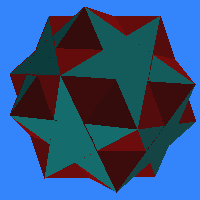Quasiregular Polyhedra
There are three convex quasiregular solids:
- With m=3 and n=4 we have the cuboctahedron.
With m=3 and n=5 we have the icosidodecahedron.
We also allow m=n=3 and include the octahedron.
The first two are Archimedean,
and the last is Platonic.
 Observe
in each case that four faces meet at each vertex in the cyclic order (m,
n, m, n). Because of this, these polyhedra have some special properties.
One is that their edges form a system of great circles. The edges of the
octahedron form three squares; the edges of the cuboctahedron form four
hexagons, and the edges of the icosidodecahedron form six decagons. These
"equators" of edges allow the derivation of the 'hemihedra" mentioned below.
Observe
in each case that four faces meet at each vertex in the cyclic order (m,
n, m, n). Because of this, these polyhedra have some special properties.
One is that their edges form a system of great circles. The edges of the
octahedron form three squares; the edges of the cuboctahedron form four
hexagons, and the edges of the icosidodecahedron form six decagons. These
"equators" of edges allow the derivation of the 'hemihedra" mentioned below.
A second property of these polyhedra is that their vertex figures are rectangles. Thus their duals have rhombic faces and are rhombic zonohedra.
A third property of the quasiregular polyhedra is that they and their duals are "edge-regular" meaning all their edges are equivalent. The other Archimedean solids have all vertices equivalent but at least two types of faces and edges. The Archimedean duals have all faces equivalent, but at least two types vertices and edges. However, the Platonic solids and the quasiregular solids and their duals have all edges equivalent (and as a consequence, all dihedral angles equal).
Another fourth property of these quasiregular polyhedra is that in each case they are the intersection of a Platonic solid compounded with its dual. The interior of the compound of the cube and octahedron is the cuboctahedron. The interior of the compound of the dodecahedron and icosahedron is the icosidodecahedron. And, the interior of the compound of two tetrahedra is the octahedron. Generally, a quasiregular solid is to be found inside the compound of {m, n} and {n, m}. The vertices of the quasiregular solid are the midpoints of the edges of the Platonic solids. Thus, the above quasiregular solids can be obtained by truncating the platonic solids to the edge midpoints.
Among the nonconvex polyhedra are the
following two examples of type (m, n, m, n):
- With m=5 and n=5/2, we find the dodecadodecahedron. (hexagons for equators)
- With m=3 and n=5/2, we find the great icosidodecahedron. (10/3 equators)
which can be derived by truncating the Kepler-Poinsot
polyhedra
at their edge midpoints. The duals to these are nonconvex
zonohedra.
 There
are also three nonconvex examples of type (m, n, m, n, m, n). In
this group there are no "equators" of edges:
There
are also three nonconvex examples of type (m, n, m, n, m, n). In
this group there are no "equators" of edges:
- The small triambic icosidodecahedron has m=3 and n=5/2.
- The triambic dodecadodecahedron has m=5/3 and n=5.
- The great triambic icosidodecahedron has m=3 and n=5.
Notice that these three each have the same vertices and edges as
the compound of five
cubes. The duals to these have hexagonal faces, and are generalized
zonohedra.
The final group consists of the nine "hemihedra," in which some faces
pass through the polyhedron's center. These "hemi" faces each cut a sphere
into two hemispheres. The "hemi" can be understood as dividing the
following Greek prefix by two, for example, an "icosihemidodecahedron"
has 20 faces of one type and 6 of another.
- tetrahemihexahedron (3, 4, 3, 4)
- octahemioctahedron (3, 6, 3, 6)
- cubohemioctahedron (4, 6, 4, 6)
- small icosihemidodecahedron (3, 10, 3, 10)
- small dodecahemidodecahedron (5, 10, 5, 10)
- great dodecahemiicosahedron (5/2, 6, 5/2, 6)
- small dodecahemiicosahedron (5, 6, 5, 6)
- great dodecahemidodecahedron (5/2, 10/3, 5/2, 10/3)
- great icosihemidodecahedron (3, 10/3, 3, 10/3)
Of the four faces which meet at any vertex, the larger two intersect
each other in a line passing through the polyhedron's center. Each of these
nine is related to one of the first five quasiregular solids above above
by eliminating one of the two types of faces and inserting faces which
span the "equators" of edges. Either
m-sided or n-sided polygons
can be eliminated, so we get two possibilities from each of the five except
the octahedron where m=n. These have no finite duals.
These complete the list of all the
quasiregular solids.